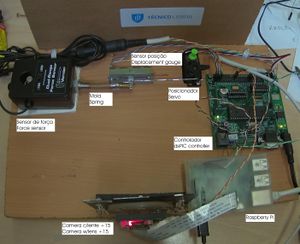Difference between revisions of "Physical Pendulum"
(Created page with "=Experiment Description= A physical pendulum consists of a rigid body that undergoes fixed axis rotation about a fixed point. In the present case it has a rigid rod structure...") |
|||
| Line 1: | Line 1: | ||
=Experiment Description= | =Experiment Description= | ||
| − | A physical pendulum consists of a rigid body that undergoes fixed axis rotation about a fixed point. In the present case it has a rigid rod structure and a mass whose position can vary from | + | A physical pendulum consists of a rigid body that undergoes fixed axis rotation about a fixed point. In the present case it has a rigid rod structure and a mass whose position can vary from 152mm to 248mm. |
| − | The purpose of this experiment is to verify how the pendulum's motion varies with the length between the fulcrum and the mass position. | + | The purpose of this experiment is to verify how the pendulum's motion varies with the length between the fulcrum and the mass position and its damped factor according to the initial displacement (the same is to say the initial energy). |
| Line 9: | Line 9: | ||
<div class="mw-collapsible-content"> | <div class="mw-collapsible-content"> | ||
| − | *Video: rtsp://elabmc.ist.utl.pt/.sdp | + | *Video: rtsp://elabmc.ist.utl.pt/pendulogravitico.sdp |
*Laboratory: Basic in e-lab.ist.eu[http://e-lab.ist.eu] | *Laboratory: Basic in e-lab.ist.eu[http://e-lab.ist.eu] | ||
| − | *Control room: | + | *Control room: Gravity Pendulum |
*Grade: * | *Grade: * | ||
| Line 20: | Line 20: | ||
=Experimental Apparatus= | =Experimental Apparatus= | ||
| − | This | + | This experiment consists on a pendulum composed by a variable position mass along a rigid rod. The pendulum's mass slides on the rod and it's possible to define the height of the mass over the rod. It's also possible to define the initial angle and the frequency for the acquisitions (sample rate) as the pendulum oscillates. |
| − | The | ||
| + | Historically pendulums are used since about the year 1600 and it's discovery and first studies are assigned to Galileo Galilei. Its regular oscillation allows it to be used to measure time quite accurately until very recently, and the fine tuning of its length allowed for regulating pendulum clocks very precisely. Pendulums were also used to perform the first measurements of the acceleration of gravity. | ||
| − | The | + | The experiment allows the pendulum to be launched from different initial angular positions and it is possible to choose the length of the pendulum rod and the sample rate to an upper time of 10 s. At the top of the pendulum rod is attached a magnetic head of a conventional hard disk that allows determining the angular position of the pendulum over time and infer the velocity by calculating its differential. |
| − | |||
| − | The | + | The apparatus is composed by a servo motor to position the mass over the a rod and another servo for the initial displacement. |
| − | + | [[File:mola-montagem.jpg|thumb|alt=Experimental setup|Setup]] | |
=Protocol= | =Protocol= | ||
| − | The user must specify the | + | The user must specify the mass position, the number of samples, the frequency between them and the initial angle. This last option indirectly defines the speed at which the experiment occurs. |
| − | |||
| − | |||
=Links= | =Links= | ||
| − | + | Página em Português | |
| − | |||
Revision as of 18:30, 26 February 2019
Experiment Description
A physical pendulum consists of a rigid body that undergoes fixed axis rotation about a fixed point. In the present case it has a rigid rod structure and a mass whose position can vary from 152mm to 248mm.
The purpose of this experiment is to verify how the pendulum's motion varies with the length between the fulcrum and the mass position and its damped factor according to the initial displacement (the same is to say the initial energy).
Links
- Video: rtsp://elabmc.ist.utl.pt/pendulogravitico.sdp
- Laboratory: Basic in e-lab.ist.eu[1]
- Control room: Gravity Pendulum
- Grade: *
Experimental Apparatus
This experiment consists on a pendulum composed by a variable position mass along a rigid rod. The pendulum's mass slides on the rod and it's possible to define the height of the mass over the rod. It's also possible to define the initial angle and the frequency for the acquisitions (sample rate) as the pendulum oscillates.
Historically pendulums are used since about the year 1600 and it's discovery and first studies are assigned to Galileo Galilei. Its regular oscillation allows it to be used to measure time quite accurately until very recently, and the fine tuning of its length allowed for regulating pendulum clocks very precisely. Pendulums were also used to perform the first measurements of the acceleration of gravity.
The experiment allows the pendulum to be launched from different initial angular positions and it is possible to choose the length of the pendulum rod and the sample rate to an upper time of 10 s. At the top of the pendulum rod is attached a magnetic head of a conventional hard disk that allows determining the angular position of the pendulum over time and infer the velocity by calculating its differential.
The apparatus is composed by a servo motor to position the mass over the a rod and another servo for the initial displacement.
Protocol
The user must specify the mass position, the number of samples, the frequency between them and the initial angle. This last option indirectly defines the speed at which the experiment occurs.
Links
Página em Português
